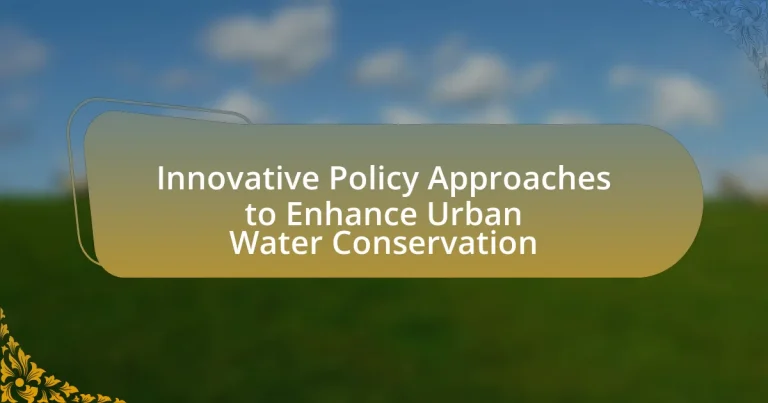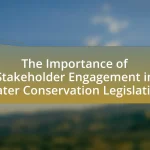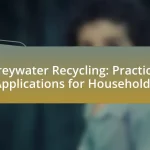The article focuses on innovative policy approaches to enhance urban water conservation, highlighting strategies such as tiered water pricing, promotion of water-efficient technologies, and mandatory restrictions during droughts. It discusses how these policies effectively address urban water scarcity by encouraging efficient water use and reducing waste. The article also examines the challenges urban areas face, including high population density and aging infrastructure, and contrasts innovative policies with traditional methods. Additionally, it emphasizes the importance of stakeholder engagement, technology, and public awareness in successfully implementing these conservation measures, ultimately contributing to sustainability goals and environmental protection.
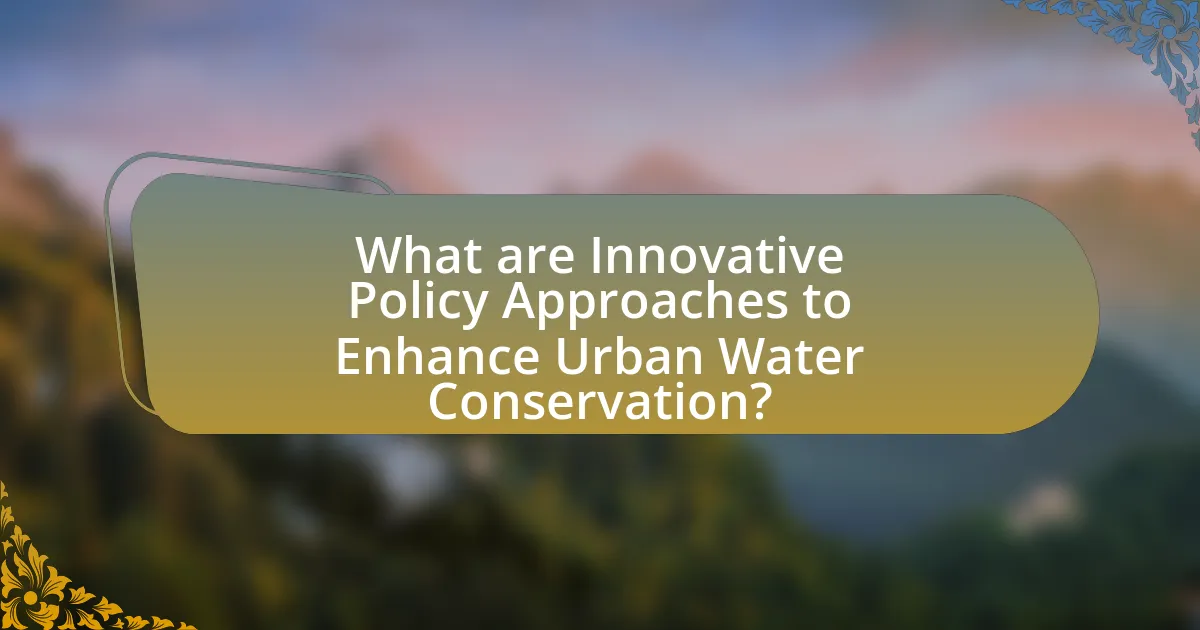
What are Innovative Policy Approaches to Enhance Urban Water Conservation?
Innovative policy approaches to enhance urban water conservation include implementing tiered water pricing, promoting water-efficient technologies, and establishing mandatory water use restrictions during drought conditions. Tiered pricing incentivizes reduced consumption by charging higher rates for excessive use, which has been shown to decrease overall water usage in cities like San Francisco, where a 10% reduction was observed after its implementation. Additionally, promoting water-efficient technologies, such as low-flow fixtures and smart irrigation systems, can significantly reduce water waste; for instance, the adoption of such technologies in Australia led to a 30% decrease in urban water consumption. Lastly, mandatory restrictions during droughts, as seen in California, effectively curtail water use, resulting in a 25% reduction during severe drought periods. These approaches collectively contribute to sustainable urban water management.
How do these policies address urban water scarcity?
These policies address urban water scarcity by implementing measures that promote efficient water use and conservation practices. For instance, policies may include incentives for water-saving technologies, regulations on water usage during drought conditions, and public awareness campaigns to educate residents about water conservation. Evidence from cities that have adopted such policies shows a significant reduction in water consumption; for example, Los Angeles reported a 20% decrease in per capita water use over a decade due to stringent conservation measures.
What specific challenges do urban areas face regarding water conservation?
Urban areas face significant challenges regarding water conservation, primarily due to high population density, aging infrastructure, and competing water demands. High population density leads to increased water consumption, making it difficult to implement effective conservation measures. Aging infrastructure often results in substantial water loss through leaks, with estimates suggesting that urban areas can lose up to 30% of their water supply due to such inefficiencies. Additionally, competing demands from residential, industrial, and agricultural sectors create conflicts over water allocation, complicating conservation efforts. These factors collectively hinder the ability of urban areas to implement sustainable water management practices effectively.
How do innovative policies differ from traditional approaches?
Innovative policies differ from traditional approaches primarily in their adaptability and focus on sustainability. While traditional policies often rely on established methods and regulatory frameworks, innovative policies incorporate new technologies, stakeholder engagement, and data-driven decision-making to address contemporary challenges. For instance, traditional water conservation strategies may emphasize fixed quotas or restrictions, whereas innovative policies might utilize smart water management systems that adjust usage based on real-time data, leading to more efficient resource allocation. This shift is supported by studies showing that cities implementing innovative water conservation policies, such as those leveraging IoT technology, have achieved up to 30% reductions in water usage compared to those adhering to traditional methods.
Why is urban water conservation important?
Urban water conservation is important because it ensures the sustainable management of water resources in densely populated areas, where demand often exceeds supply. Effective conservation practices can reduce water waste, lower utility costs, and mitigate the impacts of droughts and climate change. For instance, the U.S. Environmental Protection Agency reports that urban areas can save up to 30% of their water use through conservation measures, which not only preserves vital water supplies but also protects local ecosystems and reduces energy consumption associated with water treatment and distribution.
What are the environmental impacts of water wastage in urban settings?
Water wastage in urban settings leads to significant environmental impacts, including depletion of local water resources and increased energy consumption for water treatment and distribution. The excessive use of water can result in lower water levels in rivers and lakes, disrupting aquatic ecosystems and reducing biodiversity. Additionally, the energy required to pump, treat, and transport water contributes to greenhouse gas emissions, exacerbating climate change. For instance, the U.S. Environmental Protection Agency estimates that water treatment and distribution account for approximately 3-4% of total energy consumption in the country. This highlights the interconnectedness of water wastage and broader environmental issues, emphasizing the need for effective urban water conservation policies.
How does urban water conservation contribute to sustainability goals?
Urban water conservation significantly contributes to sustainability goals by reducing water consumption, which in turn lowers energy use and greenhouse gas emissions associated with water treatment and distribution. Efficient water use minimizes the strain on local water resources, ensuring their availability for future generations and maintaining ecosystem health. For instance, the U.S. Environmental Protection Agency reports that water conservation can save up to 30% of water use in urban areas, leading to substantial reductions in energy consumption and carbon footprint. This alignment with sustainability goals promotes resilience against climate change and supports the overall health of urban environments.
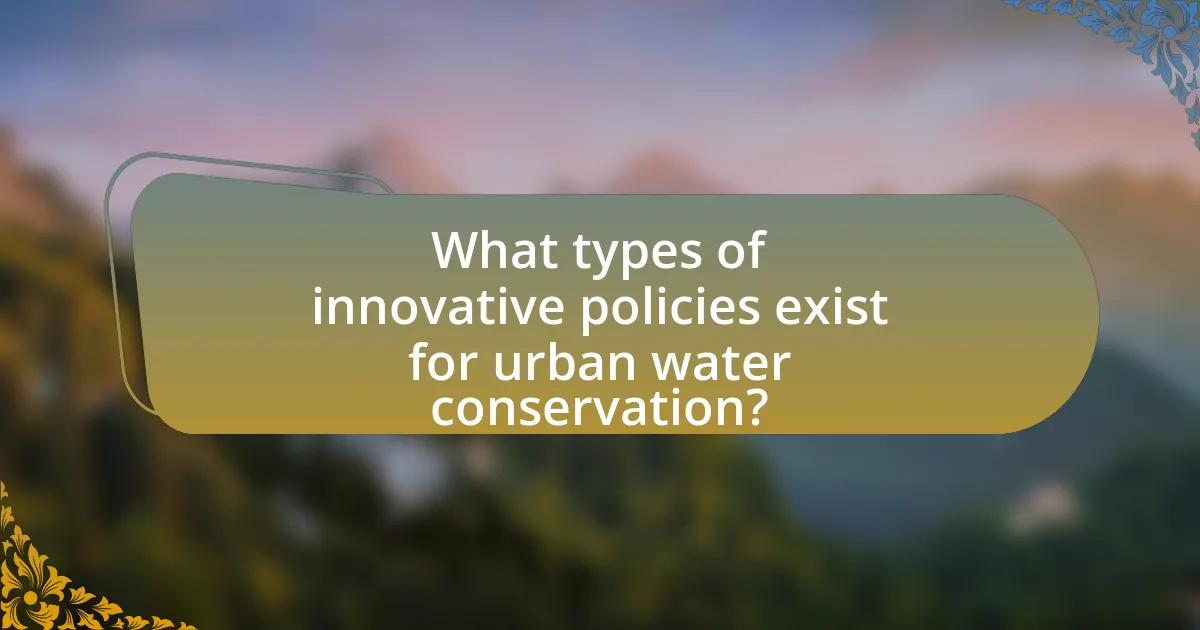
What types of innovative policies exist for urban water conservation?
Innovative policies for urban water conservation include tiered water pricing, water-efficient building codes, and incentive programs for water-saving technologies. Tiered water pricing charges higher rates for excessive water use, encouraging conservation among consumers. Water-efficient building codes mandate the installation of water-saving fixtures and appliances in new constructions, significantly reducing overall water consumption. Additionally, incentive programs, such as rebates for rainwater harvesting systems or drought-resistant landscaping, motivate residents to adopt sustainable practices. These policies have been shown to effectively reduce water usage in urban areas, as evidenced by cities like San Diego, which reported a 20% reduction in water use following the implementation of such measures.
How do regulatory measures promote water conservation?
Regulatory measures promote water conservation by establishing legal frameworks that mandate efficient water use and limit waste. These regulations often include restrictions on water usage during drought conditions, incentives for water-saving technologies, and penalties for excessive consumption. For example, California’s water conservation regulations during the 2012-2016 drought led to a 25% reduction in urban water use, demonstrating the effectiveness of such measures in achieving significant conservation outcomes.
What are the key regulations that support water-saving technologies?
Key regulations that support water-saving technologies include the Clean Water Act, which establishes standards for water quality and encourages the adoption of efficient water use practices. Additionally, the Energy Policy Act mandates water-efficient fixtures and appliances, promoting technologies that reduce water consumption. The WaterSense program, initiated by the Environmental Protection Agency, provides certification for water-efficient products, further incentivizing the market for water-saving technologies. These regulations collectively aim to enhance urban water conservation by setting standards and encouraging innovation in water-saving practices.
How do penalties for water overuse influence consumer behavior?
Penalties for water overuse significantly influence consumer behavior by incentivizing reduced water consumption. When consumers face financial repercussions for exceeding water usage limits, they are more likely to adopt conservation practices, such as fixing leaks, using water-efficient appliances, and altering their daily habits to minimize water waste. Research conducted by the American Water Works Association indicates that municipalities implementing tiered pricing structures, which impose higher rates for excessive use, have seen a reduction in water consumption by up to 20%. This demonstrates that the threat of penalties effectively encourages consumers to be more mindful of their water usage, ultimately contributing to urban water conservation efforts.
What role do incentives play in encouraging water conservation?
Incentives play a crucial role in encouraging water conservation by motivating individuals and organizations to adopt water-saving practices. Financial incentives, such as rebates for water-efficient appliances or reduced utility rates for lower consumption, directly influence consumer behavior by making conservation economically beneficial. For instance, a study by the American Water Works Association found that rebate programs can lead to a 20-30% reduction in water usage among participants. Additionally, non-monetary incentives, such as recognition programs or educational campaigns, can enhance awareness and foster a culture of conservation, further driving behavioral change. These strategies collectively demonstrate that well-structured incentives effectively promote sustainable water use.
What types of financial incentives are most effective?
Performance-based financial incentives are the most effective types of financial incentives for enhancing urban water conservation. These incentives, such as rebates for water-efficient appliances or tiered pricing structures that reward lower water usage, directly encourage consumers to reduce their water consumption. Research indicates that performance-based incentives can lead to significant reductions in water use; for example, a study by the American Water Works Association found that rebate programs for water-efficient fixtures resulted in an average water savings of 20-30% among participants. This demonstrates that targeted financial incentives effectively motivate behavioral changes that contribute to urban water conservation efforts.
How do public awareness campaigns complement these incentives?
Public awareness campaigns enhance urban water conservation incentives by educating the community about the importance of water conservation and encouraging behavioral changes. These campaigns provide critical information that helps individuals understand how their actions impact water resources, thereby increasing the effectiveness of financial or regulatory incentives. For example, studies have shown that communities with strong public awareness initiatives see a higher adoption rate of water-saving technologies, such as low-flow fixtures, which can lead to a significant reduction in water usage. This synergy between awareness and incentives creates a more informed public that is motivated to participate in conservation efforts, ultimately leading to more sustainable water management practices.
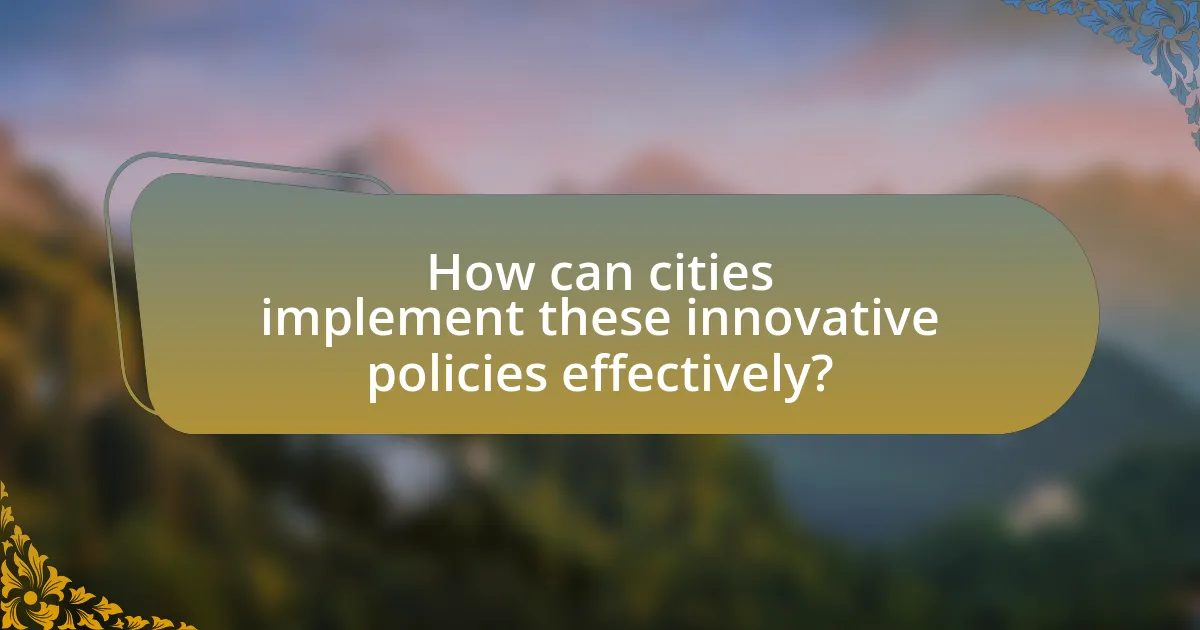
How can cities implement these innovative policies effectively?
Cities can implement innovative policies for urban water conservation effectively by adopting a multi-faceted approach that includes stakeholder engagement, data-driven decision-making, and regulatory frameworks. Engaging local communities and businesses fosters collaboration and ensures that policies meet the specific needs of the population, as evidenced by successful initiatives in cities like San Francisco, where public input led to tailored water-saving programs. Utilizing data analytics allows cities to monitor water usage patterns and identify areas for improvement, which has been shown to enhance the effectiveness of conservation efforts, as seen in the case of Los Angeles, where data-driven strategies resulted in a 20% reduction in water consumption over five years. Establishing clear regulatory frameworks that incentivize water-saving technologies and practices, such as rebates for low-flow fixtures, has proven effective in cities like Tucson, which reported a significant increase in the adoption of water-efficient appliances following the implementation of such policies.
What strategies can be employed for successful policy implementation?
Successful policy implementation can be achieved through stakeholder engagement, clear communication, and adaptive management. Engaging stakeholders, including community members and local organizations, fosters collaboration and ensures that diverse perspectives are considered, which enhances buy-in and support for the policy. Clear communication of the policy goals and benefits helps to align expectations and reduce resistance. Adaptive management allows for flexibility in response to unforeseen challenges, enabling policymakers to adjust strategies based on feedback and outcomes. Research indicates that policies with strong stakeholder involvement and clear communication are more likely to succeed, as evidenced by case studies in urban water conservation initiatives that demonstrate increased compliance and effectiveness.
How can stakeholder engagement enhance policy effectiveness?
Stakeholder engagement enhances policy effectiveness by fostering collaboration and ensuring that diverse perspectives are considered in the decision-making process. When stakeholders, including community members, businesses, and governmental agencies, actively participate, policies are more likely to address the actual needs and concerns of the affected populations. For instance, research by the International Council for Local Environmental Initiatives (ICLEI) indicates that inclusive stakeholder processes lead to higher compliance rates and better implementation of environmental policies. This is evidenced by case studies where urban water conservation initiatives, such as those in Melbourne, Australia, successfully reduced water usage by 30% through community involvement and feedback mechanisms. Thus, effective stakeholder engagement not only improves policy relevance but also enhances accountability and trust among all parties involved.
What role does technology play in the implementation process?
Technology plays a critical role in the implementation process of innovative policy approaches to enhance urban water conservation by enabling efficient data collection, analysis, and management. For instance, smart water meters provide real-time usage data, allowing municipalities to monitor consumption patterns and identify leaks promptly. Additionally, geographic information systems (GIS) facilitate the mapping of water resources and infrastructure, aiding in strategic planning and resource allocation. Research indicates that cities employing advanced technologies, such as IoT sensors and data analytics, have achieved up to 30% reductions in water usage, demonstrating the effectiveness of technology in optimizing water conservation efforts.
What challenges might cities face in adopting these policies?
Cities may face significant financial constraints when adopting innovative water conservation policies. Budget limitations can hinder the implementation of necessary infrastructure upgrades and technology investments. For instance, a study by the American Society of Civil Engineers highlights that U.S. cities require an estimated $126 billion annually to maintain and improve water systems, which can be a barrier to adopting new conservation measures. Additionally, resistance from stakeholders, including residents and businesses, can complicate policy adoption, as they may be concerned about potential costs or changes to existing practices. Furthermore, regulatory challenges can arise, as cities must navigate complex legal frameworks and obtain necessary approvals, which can delay or obstruct the implementation of innovative policies.
How can cities overcome resistance from the public or businesses?
Cities can overcome resistance from the public or businesses by engaging in transparent communication and fostering collaboration. By actively involving stakeholders in the decision-making process, cities can address concerns and build trust. For instance, studies show that participatory planning increases public support for urban initiatives, as seen in the case of the San Francisco Public Utilities Commission, which successfully implemented water conservation measures through community engagement. This approach not only mitigates resistance but also enhances the effectiveness of policies aimed at urban water conservation.
What are the financial implications of implementing innovative water policies?
Implementing innovative water policies can lead to significant financial implications, including cost savings, increased investment, and potential economic growth. For instance, adopting advanced water management technologies can reduce operational costs for municipalities by up to 30%, as evidenced by case studies from cities like San Diego, which reported savings of approximately $1.5 million annually through smart irrigation systems. Additionally, innovative policies can attract private investment; the global market for water technology is projected to reach $1 trillion by 2025, indicating a robust opportunity for economic development. Furthermore, effective water conservation strategies can enhance property values and stimulate local economies, as seen in regions that have successfully implemented sustainable water practices.
What best practices can cities adopt for urban water conservation?
Cities can adopt several best practices for urban water conservation, including implementing tiered water pricing, promoting water-efficient appliances, and enhancing green infrastructure. Tiered water pricing encourages residents to reduce consumption by charging higher rates for excessive use, which has been shown to decrease overall water usage by up to 20% in various municipalities. Promoting water-efficient appliances, such as low-flow toilets and showerheads, can significantly reduce indoor water consumption; for instance, the U.S. Environmental Protection Agency estimates that these measures can save households approximately 20-30% of their water use. Additionally, enhancing green infrastructure, such as rain gardens and permeable pavements, helps manage stormwater and reduces the demand on municipal water systems, contributing to sustainable urban water management.
How can cities measure the success of their water conservation policies?
Cities can measure the success of their water conservation policies by analyzing water usage data before and after policy implementation. This involves tracking metrics such as total water consumption, per capita water use, and changes in demand during drought periods. For instance, a study by the American Water Works Association found that cities implementing tiered water pricing saw a reduction in water use by 10-20%. Additionally, cities can assess the effectiveness of public awareness campaigns through surveys measuring changes in community attitudes and behaviors regarding water conservation. These quantitative and qualitative assessments provide concrete evidence of policy impact.
What lessons can be learned from cities that have successfully implemented these policies?
Cities that have successfully implemented innovative water conservation policies demonstrate the importance of community engagement and education. For instance, San Francisco’s water conservation program, which includes public outreach and incentives for water-efficient appliances, resulted in a 20% reduction in water use over a decade. This success highlights that involving residents in the decision-making process and providing clear information about the benefits of conservation can lead to significant behavioral changes. Additionally, cities like Melbourne have shown that integrating technology, such as smart meters, can enhance monitoring and management of water usage, leading to more informed policy adjustments and improved conservation outcomes. These examples underscore the effectiveness of combining community involvement with technological advancements to achieve sustainable water management.
